Diving on the Great Barrier Reef: MOUA and SS Yongala
From a maritime tragedy, a tourism triumph has emerged and put Australia on the map.
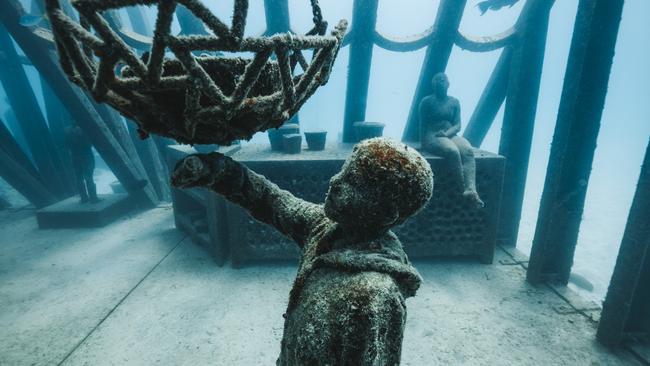
When passenger steamer SS Yongala embarked from Mackay, 1000km north of Brisbane, on March 23, 1911, a new wireless radio was sitting on the dock in Cairns, waiting to be installed. The captain and crew of the ship, built in 1903 for the Adelaide Steamship Co, still relied on signal flags for communication, and warnings of an imminent cyclone were fatefully missed.
Its failure to arrive in Townsville didn’t initially ring alarm bells; authorities assumed it had sheltered from the storm and would soon appear in Cleveland Bay. Three days later, however, cargo and wreckage began washing ashore. A seven-day search ensued to no avail. Not one of the 122 passengers was found, not even a life raft, indicating the vessel had gone down suddenly. Only the shark-ravaged carcass of prize-winning racehorse, Moonshine, which had been destined for Townsville’s track, surfaced.
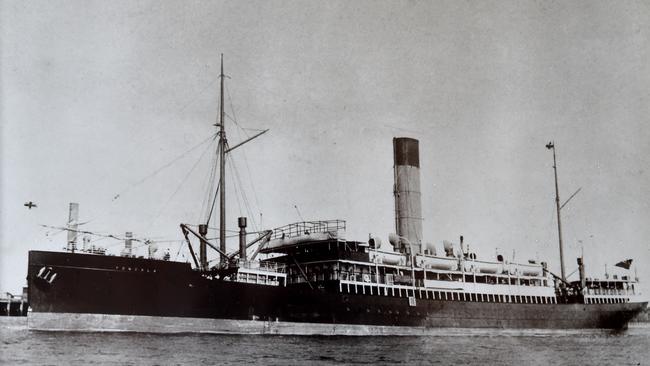
The resting place of the Yongala remained a mystery for almost 50 years. A minesweeping operation by the navy in 1947 identified what was believed to be a shoal about 90km southeast of Townsville but it wasn’t investigated further. It wasn’t until 1958 that the wreck was identified, with an empty Chubb safe brought to the surface, sent off to London and the serial number confirmed. SS Yongala had finally been found.
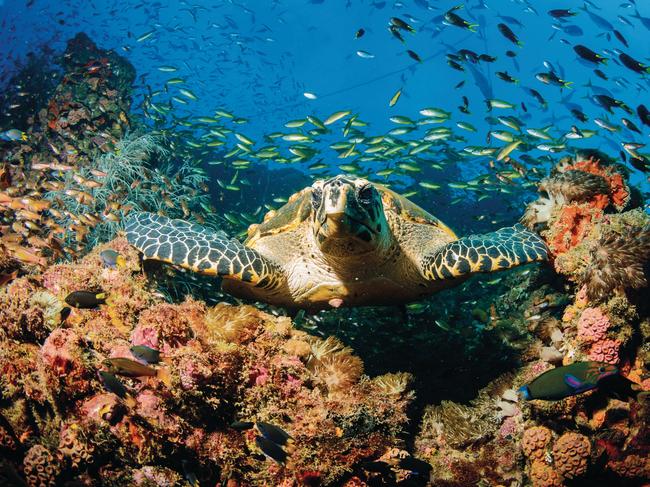
From tragedy has emerged a tourism triumph, with the Yongala now ranked among the top five wreck dives in the world and, pre-Covid, attracted thousands of scuba divers a year. Protected under the Historic Shipwrecks Act and a designated gravesite, the 110m-long structure can’t be entered by divers. It’s not some macabre search for skeletons that brings divers here, however; it’s the marine life. The Yongala has become a thriving artificial reef that supports an astonishing array of species, most of which appear to have taken some kind of growth hormone – they are gigantic. There are hefty groupers up to 3m long; schools of silvery barracuda and giant trevally; curious Maori wrasse; spotty eagle and marble rays with vast wing spans; bullsharks, sea snakes and turtles, not to mention abundant coral and tiny tropical fish. A place of enormous loss has become a thriving ecosystem.
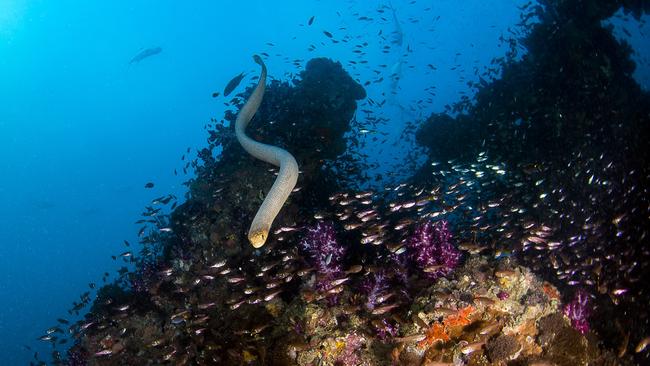
My family and I have come with Adrenalin Snorkel and Dive, motoring 2½ hours from our holiday digs on Magnetic Island, to see it for ourselves. Right on cue on arrival at the site’s permanent mooring, an olive sea snake zigzags over the ocean’s surface. It’s a herald of what’s to come.
Lying on its starboard side at a depth of 30m, the Yongala is not the easiest wreck to explore (inexperienced divers must be accompanied by a guide). Ocean currents are notoriously strong, and on entering the water it feels like I could be swept all the way to Vanuatu if my white-knuckle grip on the descent rope slipped. One of Adrenalin’s crew members, who’s been diving here for four years, says she’s never experienced a current like it.

Once we reach the top of the ship, at about 15m deep, the water’s pull thankfully eases and we can take in our surrounds. In calm conditions, it’s possible to spot several features still visible, including a cast iron bath, anchor winch and the first-class loos. With today’s limited visibility, we concentrate on the abundant sea creatures swarming around. We tick off nearly everything on the list except, disappointingly, sharks, but my two teenagers are excited to see a marble ray swoop past. As we begin our ascent, two turtles the size of hefty coffee tables watch regally from their resting place on the Yongala’s hull.
Paul Crocombe, who founded Adrenalin Snorkel and Dive 34 years ago, has been visiting the Great Barrier Reef since he was a teen and has seen plenty of changes over the decades. Perhaps controversially for a tourism operator, he believes UNESCO should have reclassified the 2300km landmark as endangered last year, “so people sit up and take notice. People can be reluctant to talk about it.”
He is, however, highly optimistic about the reef’s future, while acknowledging that climate change is the most critical issue it faces. “I believe the reef is very resilient. Depending on what happens with the climate, the reef might not look the same as it does now but we’ll still have a reef,” he says.
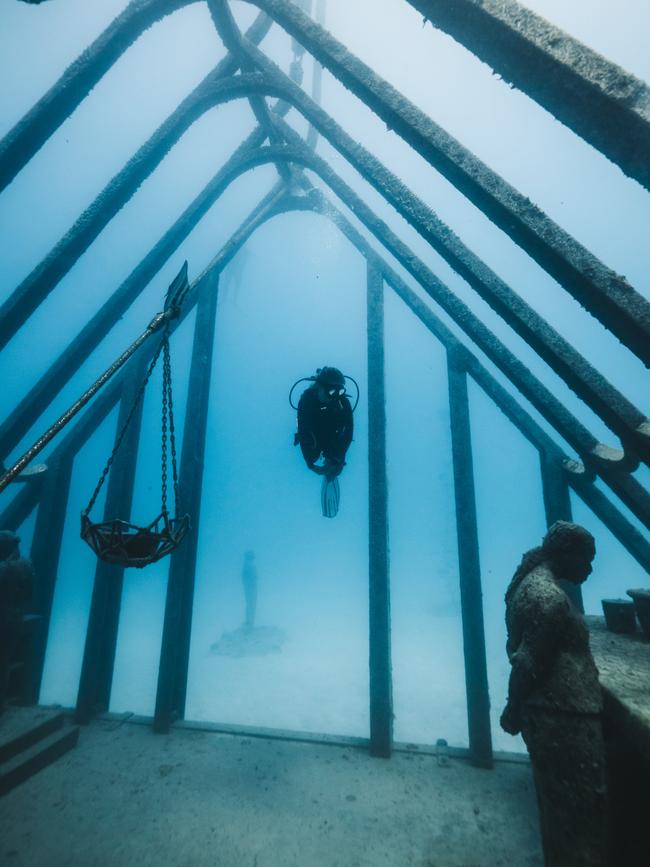
When it was announced that a Museum of Underwater Art accessible to scuba divers and snorkellers was going to be created off the coast from Townsville, Crocombe was sceptical. Since its opening in 2020, however, he’s become a fan, seeing its potential as a way to “reinforce the fact the reef is in good condition” and prove it’s not a bleached wasteland. He also believes MOUA encourages visitors to consider their environmental impact, and learn about the reef’s significance to Indigenous communities.
On a second outing with Adrenalin, as snorkellers bob above us, we do two dives at John Brewer Reef and I’m blown away by the array of colour and fish life. The area is covered in sprawling plate, staghorn and fan corals. Bolshy clownfish poke their heads from anemones, parrotfish munch on their surrounds and a black-tip reef shark glides past. A turtle gracefully swims into the distance, its fins flapping like a bird in slow motion, and a courageous crayfish tries to scare me off by shooting out a burst of sand. There are narrow canyons to swim through, and caves thick with thousands of tiny fish.

At a depth of about 16m adjacent to the reef stands an arched, chapel-like structure called the “coral greenhouse”. Inside it, and dotted on the ocean floor around, are sculptures of people, or “reef guardians”, and trees.
One statue cradles a pot “planted” with coral cuttings; another peers into a microscope. They are the creation of world-renowned underwater sculptor Jason deCaires Taylor, whose works span several continents and include the hugely popular MUSA underwater museum in Mexico. Made from stainless steel and pH-neutral materials, the greenhouse and its artistic inhabitants are designed to promote coral growth, while objects within are specifically shaped to shelter the likes of octopus, sea urchins and small fish.

Already, the sculptures are wearing fuzzy coats of marine growth. In five or 10 years, the scene is likely to be completely different. This is a dynamic work of art that draws on concepts of gardening, cultivation, nurturing and science, with child-size figures emphasising the Great Barrier Reef’s importance to future generations.
It’s a serene experience, immersed in a gentle blue world with only the snap, crackle and pop of sealife and the rhythmic bubbling of my breath through my regulator. A platoon of barracuda is hanging out by one of the “trees”, as if in suspended animation, giving me the fiercest side-eye imaginable. This is their place; I’m just visiting.
In the know
Adrenalin Snorkel and Dive runs day trips to SS Yongala; $344 a person for two dives with full equipment hire (minimum open water certification with six logged dives). Day trips to John Brewer reef and MOUA are $274 a person for snorkellers; $359 for certified divers with full equipment hire.
Penny Hunter was a guest of Adrenalin Snorkel and Dive and Townsville Enterprise.


To join the conversation, please log in. Don't have an account? Register
Join the conversation, you are commenting as Logout